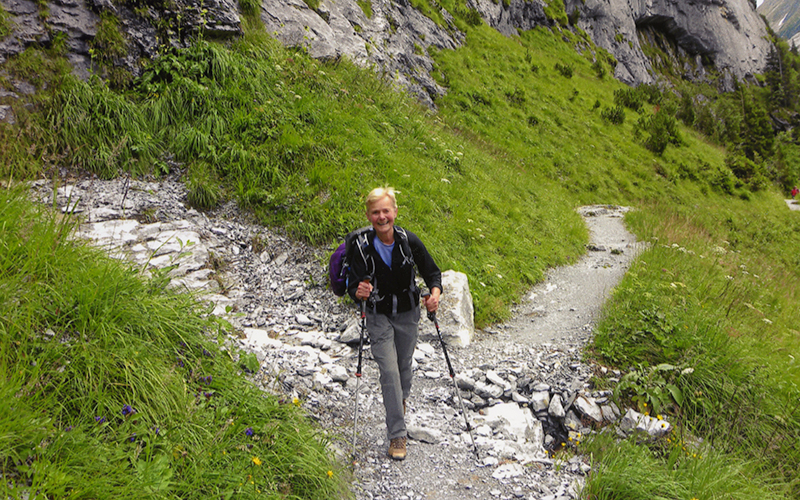
Knowing the end of the trail could come at any time, the author booked her calendar full of hiking trips.
During years of appointments, my doctor and I have spent as much time talking about our hiking trips as about my age and medical diagnoses. A while ago, he casually said, “People who have the hardest time facing the realities of physical decline are those who have had an active outdoor life.”
He offered these words as salve for the hurt I was feeling as I reached the end of my hiking days. It helped that, years before, I had already concluded I could never satiate my love of hiking, no matter how long I lived. The beautiful and rough wild found in the mountains, especially the very remote, won my heart at first sight. That was where I understood my place on Earth and where I was spiritually replenished: by the forests, the grand open spaces, the ancient cairns, the aurora borealis, the glaciers, the alpine flowers, the wolverines, and the warblers’ songs.
Looking back, I can pinpoint the date—February 19, 1984—when fate set in motion the conditions that ultimately would end my days as a hiker. On that cold, sunny day, a friend and I went cross-country skiing on Pleasant Mountain in Bridgton, Maine. Pretty quickly, we realized the corn snow was too mushy to enjoy skiing and turned around for home. A steep, curving slope led to the dirt road where we had parked. I volunteered to go first, not calculating the danger of such a precipitous decline. I tucked down on my skis and was rounding the curve when a stick shot up out of the ground, impaling me vertically from the back of my upper right thigh through the bowels to the abdominal aorta.
My first thought was whether I was paralyzed. Wiggling my toes gave me the answer. My spine was OK. I would still be able to hike. The stick had brushed by my femoral artery instead of severing it. Without that luck, Pleasant Mountain would have been my last adventure. I was 42 years old, and as dreadful as the accident was, I recovered, thinking that was the end of that.
Over the next 30 years, I hiked, paddled, and climbed ice and rock. I didn’t perseverate about my graying hair, facial wrinkles, or memory lapses, or the many surgeries related to the accident. Hiking kept me fit.
As much as I was unprepared for such a freaky ski accident in 1984, I was equally undone by the arrival of peripheral neuropathy when I was 69. Painkillers kept me hiking, but knowing my trail time could end at any moment, I made four trips across the Atlantic in 2014 to hike in my favorite mountains in England and Scotland. I stood on top of windy 4,235-foot Ben Macdui in the Cairngorm Mountains on October 2, 2014, just shy of my 73rd birthday. Over the next year, I underwent further surgeries in hopes of getting back my outdoor life, but my 13th abdominal surgery, in 2015, slammed the hiking door. My age and frail condition kept me from even walking up the driveway.
Contemplating my situation, I wondered why I never saw articles about the emotional impact of being forced to give up hiking, skiing, or any outdoor passion at the center of one’s life. The loss is a universal experience, and I wanted to know how it affected others. When I couldn’t find a story that offered what I was seeking, I decided to write my own.
My outdoor mantra for decades has been: Do it while you can. Everyone has to decide for themselves how to meet the inescapability of aging. I find comfort in my garden that lures birds and animals. This past summer, I planted a new forest on my bayside land to replace the woods partially blown down by fierce nor’easters. Each young pine and spruce buoys my spirit and connects me still to the great wild landscapes—old and new.
Phyllis Austin, a career journalist, has written two books, Wilderness Partners: Buzz Caverly and Baxter State Park and Queen Bee: Roxanne Quimby, Burt’s Bees and Her Quest for a New National Park. She lives in Brunswick, Maine.
Editor’s note: We regretfully share the news that, since this story was published, Phyllis Austin has passed away. Read more about her life and career.